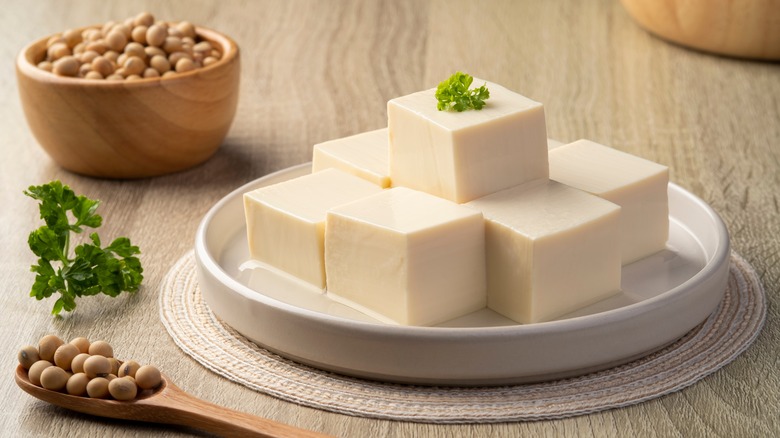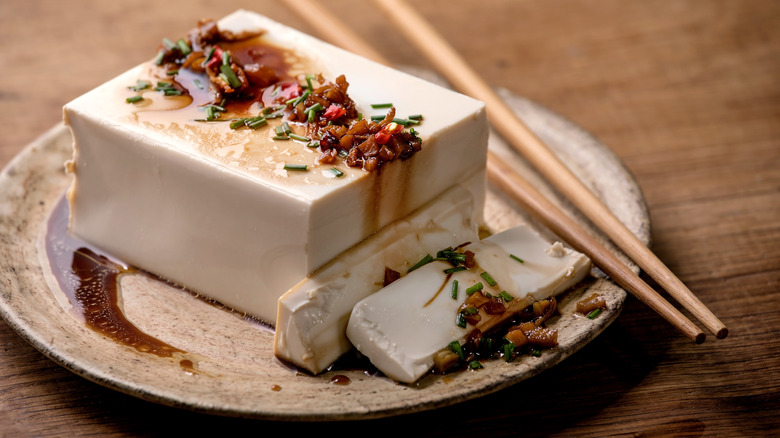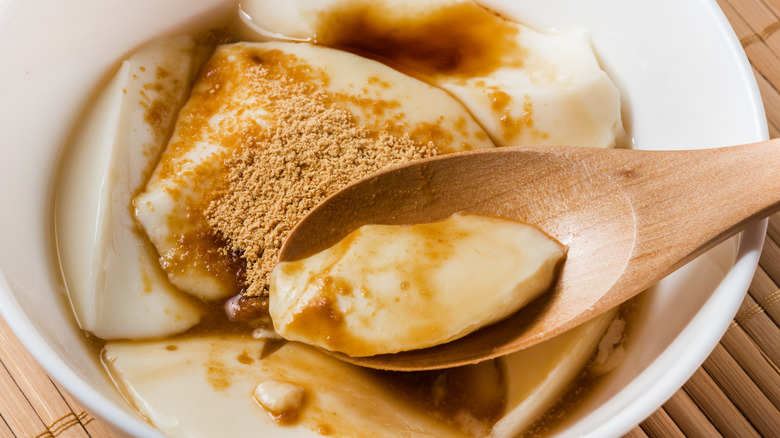Can You Eat Raw Tofu Right Out Of The Package?
You've likely been eating crisp nuggets of tofu tossed into noodles, stir-fries, and salads — or silky pieces floating in hot soups and spicy mapo sauces. Perhaps you prefer your tofu minced inside dim sums, gyozas, and potstickers or mashed into a scramble alongside buttered slices of toast. But if you have a liking for its Asian preparations, chances are, you've already tasted tofu cold, raw, and entirely uncooked.
Not only is it perfectly fine to eat raw tofu straight from the packet, but it is, in fact, fairly common to eat the soy-based protein raw in Asia, particularly in the summer when no-cook cold preparations are a welcome respite from the heat. In China, for example, cold and raw soft or silken tofu takes the form of liangban doufu whereas in Japan it is topped with soy sauce, bonito flakes, ginger, and greens onions and eaten as hiyayakko or Japanese cold tofu. There's even a sweet preparation called douhua or tofu pudding where cold ginger syrup is spooned over chilled raw tofu.
Eating raw tofu out of its packet is safe because it isn't actually raw at all — tofu by its nature is already cooked. Tofu is made from dry soybeans that have been crushed and boiled into soy milk, which is further cooked, coagulated, and pressed into dense slabs. As such, packaged tofu is already cooked, so when you eat it as it is, all that you're really doing is not heating it any further.
Raw tofu is safe to eat but here's what to keep in mind before you do
Since tofu is technically already cooked, eating it "raw" isn't the same as eating raw meat. Still, tofu is as prone to contamination as any other food – whether that's due to improper handling or exposure to other raw foods. Packaged tofu is also wrapped and stored with water, which further makes the protein susceptible to contamination — all of which can lead to food-borne illnesses.
Though the risks associated with eating raw tofu are low, those with weaker immune systems may want to be particularly careful about doing so by taking extra care about how raw tofu is handled. Discard any extra water that tofu comes packed with and make sure to use clean utensils and surfaces when prepping the tofu. When storing any leftovers, make sure that the temperature of the refrigerator is lower than 40 degrees Fahrenheit. Don't leave it out at ambient temperatures — 40 to 140 degrees Fahrenheit – otherwise known as the danger zone where bacteria can double in minutes.
Cooking also changes the texture of tofu by drawing out some of its moisture. Without it, spongey tofu won't be as firm and chewy as it would be if it were cooked in high heat. So although safe to eat, you will want to consider how you prepare it — raw tofu may not be quite as fun if you expect it to be like its cooked versions.
Ways to eat raw tofu
It's nice to know that you could eat tofu out of the packet with nothing but a spoon if you ever wanted to, but that doesn't mean that's your best option. Tofu on its own has a notorious reputation for tasting neutral, so you're still better off using it in an uncooked but seasoned preparation. Even better, raw tofu can be the secret to making many dairy-based recipes vegan, including desserts and cheese — raw tofu really should be used in preparations of its own.
Raw silken tofu is fabulous when used in anything that requires blending – think high-protein shakes and smoothies, cold dips flavored with herbs and aromatics, or thick salad dressings and sauces. Firm tofu can also be turned into a vegan sour cream, a plant-based mousse with dates and cacao powder, or a rich ice cream that doesn't have dairy.
The firmer tofus are fabulous for giving a bite to salads, sandwiches, and poke bowls — whether chopped into cubes or crumbled as a topping. Raw firm and extra firm tofu can also mimic feta cheese when seasoned with nutritional yeast, miso, an acid, and herbs — there's a vegan cheese for ya! When chopped, raw tofu also works as a substitute for eggs in vegan egg salads. Or, if you're ever in doubt, you could always slide raw tofu into a plate and season it with sauces, syrups, and spices to make liangban doufu, hiyayakko, and tofu pudding!



